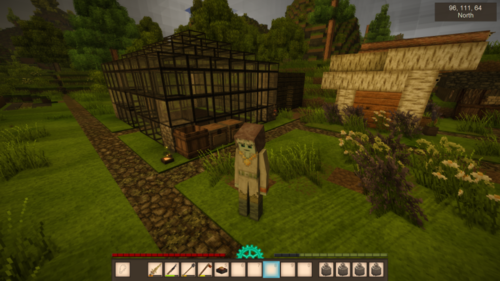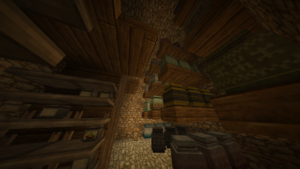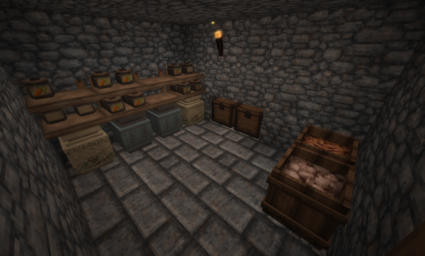Room
This page was last verified for Vintage Story version 1.19.5.
Rooms are a type of structure players may create for staying warm and avoiding the consequences of harsh winter, or to use as cellars or greenhouses.
The game checks through each block in a room to determine the sunlight level of each of the blocks inside the room and the coolness level of each of the blocks making up the walls, floor, and ceiling of the room. If it determines there are no open exits it will classify it as an enclosed room.
All valid rooms are enclosed rooms with the exception of open-air cellars for making blue cheese. All rooms additionally have a cooling score and a skylight score. These are largely relevant for two special room types, cellars and greenhouses.
When players are in a fully enclosed room, the increased hunger rate from winter will be removed. Additionally if the room has a skylight score of less than 50%,
- Heat from a heat source extends farther out into the room,
- Wind no longer reduces player body temperature,
- While sleeping, player body temperature will slowly adjust towards normal.
Creation
Any fully-enclosed space that fits within a 14x14x14 cube in size may be counted as a room by the game. All sides of the room must be enclosed with solid sides of blocks facing inwards, and all doors, including trapdoors, count as solid blocks for the sake of building a room with the exceptions of crude, sleek, and ruined doors which all count as non-airtight doors. The one exception to the general rule is that chiseled blocks do not have to have a completely solid face, and instead have to have no more than 20 voxels missing from the inward face and at least 50% of the total volume of the block in voxels to count as solid. You can check for this in-game by pointing at the block face on the chiseled block that needs to be solid and if it says "Insulating Block Face" then it counts as solid for the sake of room building.
Protip:
You can use the /debug rooms hi command to check if the room you’re standing in counts as a valid room. If it highlights green you did it correctly and it will count as an enclosed room, if it highlights red something is wrong and it doesn’t see a room. Use /debug rooms unhi to remove the highlighting! |
Greenhouse
Greenhouses are structures intended to make farming crops possible in climates that drop below the pausing point of crops for part of the year. If built correctly, the farmland, fruit trees, berries, or beehives inside of the structure will be treated as if those blocks are 5°C warmer than those outside at all times. If this effect is working, the tooltip for blocks inside the greenhouse will show a "+5°C" effect.
Creation
Greenhouses require a skylight score of at least 50%, meaning it is impossible to build one completely covered underground. Greenhouses that are set one block below ground level will still incur the underground farming penalty, if that was turned on during world creation, no matter how much sunlight it receives.
When building a greenhouse, water blocks placed between farmland counts as part of the height of the allowable 14x14x14 area - forgetting this can lead to the game not registering a newly-built greenhouse for being too large. This can be avoided by hiding water source blocks under the outer walls of the greenhouse, as the game will not count the corners as part of the room.
Protip:
Every block checks if it’s in a greenhouse after a maximum of 4 in-game hours, give or take a few seconds. Therefore, it might take a little time before the +5°C buff appears on the blocks inside of the structure, and not all blocks will be updated simultaneously. |
Skylight Score
Any blocks inside the room that have at least as much sunlight as outside the room will count toward the skylight count. The total skylight score is determined by dividing the skylight count by the total volume of blocks inside the room. Player-created light sources, such as torches and lanterns, have no impact on skylight score. Common blocks used to allow in light include glass blocks and leaded glass panes.
Protip:
While more complicated layouts will work, the simplest way to ensure you get a skylight score of at least 50% is to make it so at least half of the blocks in your ceiling allow sunlight through. Even glass slabs and glass panes will work so long as the solid side faces inward rather than outward. |
Cellar
Cellars are used to store any goods that will spoil at a much slower spoil rate compared to non-cellar rooms, or outdoors.
Creation
When detecting a room the game will make extra checks to see if the room is small enough to be a cellar. Normally this is anything within a 7x7x7 cube, but it is possible to build up to 9 blocks wide in a single direction so long as the total volume of all the blocks inside the cellar is no more than 150.
Cellars do not need to be underground to work, however since sunlight levels can affect cellar effectiveness, it may be easier to dig an underground cellar than to create an above-ground one.
Cooling Score
Any blocks may be used to create a cellar, but different blocks have different insulation values. Blocks in the stone, soil, ceramic, or ore classes are the best insulators, and will each add 1 to the cooling block total. The one exception being farmland which gives 3 to the non-cooling block total, as do trapdoors. Airtight doors add 3 per block of space they occupy when open and 1 per block when closed to the non-cooling block total. The game creates the cooling score by dividing the non-cooling block total by the cooling block total and capping the number at 1, for 100%.
As a result, the most effective cellars are made of highly insulating blocks (stone, soil, ceramic or brick, ore) and are closed with airtight doors.
Food Preservation
The main use of cellars is for food preservation, however cellars reduce the rate of spoilage for any good stored inside whether it is a food or not. This reduced rate of spoilage stacks with container types, so placing storage vessels and sealed crocks into a cellar can drastically extend the shelf-life of any food inside them.
When calculating how fast food will spoil in a cellar, the game first creates a cellar effectiveness score, which starts at 100%. Up to 40% can be deducted based on the skylight score (that is, the amount of sunlight the cellar receives), and up to 50% can be deducted based on the cellar's cooling score.
The air temperature inside the cellar will never be greater than the air temperature outside. When the effectiveness of the cellar is 100%, the air temperature will cap at 5°C. Otherwise the game will calculate air temperature inside the cellar based on the effectiveness score and skylight score, in addition to how much sunlight is in the container block being affected.
Protip:
Because there is no minimum size for a cellar, burying a vessel in a cube of soil is an extremely effective way of preserving food early-game. Just dig out the top block or a side block to access it, then replace it to seal it again. Make sure the vessel is surrounded on every side by a cooling block and never build with anything transparent or you won’t get the full bonus! |
Cheese Ripening
Cellars can also used to ripen cheese, by lowering its perish rate until it can ripen before it spoils. Cheese can only ripen when placed onto a shelf with a perish rate of 0.5x or lower. Cheddar does not have to be made in a cellar and can be made outside if it is cold enough, while blue cheese must be made in a special kind of open-air cellar with at least one open exit and the shelf must have a sunlight level below 2. This special open-air cellar will not count as an ordinary room, so it will not get the normal bonus for cooling. Blue cheese still needs to be ripened with a perish rate of 0.5x or lower, however, so blue cheese can only be ripened when it is cold enough outside to lower the perish rate to the necessary level.
Protip:
Remember if you’re trying to build an open-air cellar for ripening blue cheese, /debug rooms hi will always show those as red, but you can fill in the hole before using the command to check and make sure that it counts as a room, and then dig out the hole to make it open-air again. Placing the shelf as far away from the hole as possible and including a long and/or twisty corridor to get in and out of the cellar can help keep sunlight low as well. |
| Farming | |
|---|---|
| Wild foods | Berries • Cactus (saguaro) fruit • Mushrooms • Cattail (and papyrus) |
| Grains | Amaranth • Cassava • Flax • Rice • Rye • Spelt • Sunflower |
| Vegetables | Cabbage • Carrot • Onion • Turnip • Parsnip • Peanut • Pumpkin • Soybean |
| Fruits | Fruit trees • Pineapple |
| Other | Fertilizer • Beekeeping • Room |
| Tools | Hoe • Scythe • Fruit press |
| See also | Animal husbandry • Cooking • Food preservation |
| Wiki Navigation | |
|---|---|
| Vintage Story | Guides • Frequently Asked Questions • Soundtrack • Versions • Controls |
| Game systems | Crafting • Knapping • Clay forming • Smithing • Cooking • Temperature • Hunger • Mining • Temporal stability • Mechanical power • Trading • Farming • Animal husbandry |
| World | World generation • Biomes • Weather • Temporal storms |
| Items | Tools • Weapons • Armor • Clothing • Bags • Materials • Food |
| Blocks | Terrain • Plants • Decorative • Lighting • Functional • Ore |
| Entities | Hostile entities • Animals • NPCs • Players |
| Miscellaneous | List of client commands • List of server commands • Creative Starter Guide • Bot System • WorldEdit • Cinematic Camera • Adjustable FPS Video Recording • ServerBlockTicking |



